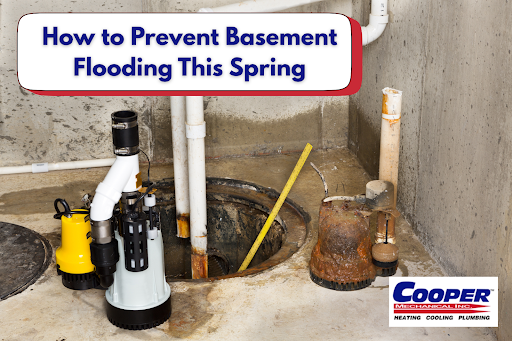Simple steps to keep your basement dry and your home protected during the rainy season.
Spring is a welcome relief after a long Pennsylvania winter—but it can also bring one of the biggest threats to a home: basement flooding. Between melting snow in Northern Bucks, heavy spring rains, and rising groundwater, many homeowners in Bucks County and the surrounding areas find themselves facing unexpected water damage this time of year.
A flooded basement isn’t just an inconvenience—it can cause structural damage, destroy valuables, lead to mold growth, and result in costly repairs. Fortunately, with a little planning and preventative care, you can avoid the headache altogether.
At The Coop, we’ve been helping local homeowners protect their properties from seasonal flooding for decades. Our team knows what it takes to keep homes dry, safe, and ready for the spring season with sump pump repairs and replacements in Bucks County. Below, we’re sharing our top expert tips to help you stay one step ahead of spring floods.
Make Sure Your Sump Pump Is Ready for Action
Your sump pump is the first line of defense against basement flooding, especially when the water table rises in the spring. If it fails during a storm, water can quickly accumulate and cause significant damage.
Here’s how to get your sump pump ready:
- Test it regularly: Pour a bucket of water into the sump pit. The pump should kick on and remove the water quickly.
- Clean the pit: Remove any debris or sediment that could block the pump or clog the discharge line.
- Inspect the power supply: Make sure the pump is plugged in and that the outlet is functioning.
- Install a backup system: A battery backup system ensures your pump works during power outages.
If your pump is more than 7–10 years old or showing signs of wear, it may be time to replace it before the next major storm hits.
Seal Cracks and Gaps in Your Basement
Water can find its way into your basement through even the smallest cracks in the foundation walls or floor.
Take these steps to seal up your basement:
- Look for signs of seepage: Stains, peeling paint, or musty smells may point to moisture entry.
- Use hydraulic cement: This expands as it sets, making it ideal for patching small cracks.
- Call a professional for larger issues: Significant foundation cracks may require structural repair or a more advanced waterproofing solution.
Keeping moisture out at the source is a key part of any basement waterproofing plan.
Clean Gutters and Extend Downspouts
One of the most common causes of spring basement flooding is poor drainage from clogged or improperly directed gutters.
Protect your home by:
- Cleaning your gutters: Remove leaves, twigs, and other debris that could cause overflows.
- Checking downspouts: Make sure water is directed at least 4–6 feet away from your home.
- Adding extensions if needed: Downspout extenders or splash blocks help prevent water from pooling near your foundation.
Keeping roof runoff away from your home can make a big difference in preventing basement moisture.
Ensure the Ground Slopes Away from the Foundation
If the soil around your home slopes inward, water will naturally drain toward the basement—exactly where you don’t want it.
- Check your grading: The ground should slope away from your foundation at a rate of about 6 inches over 10 feet.
- Add soil or adjust landscaping: If necessary, regrade low areas or reshape garden beds to improve drainage.
- Avoid landscaping that traps water: Mulch and decorative stones can sometimes hold moisture close to the house.
Proper grading keeps rainwater moving away from your home instead of toward it.
Consider Professional Basement Waterproofing Solutions
If your basement has a history of flooding or moisture issues, it’s worth investing in a long-term solution.
Professional waterproofing may include:
- Interior drainage systems: French drains or perimeter channels that direct water to a sump pump.
- Exterior waterproofing: Foundation coatings and drainage tiles to stop water before it enters the home.
- Dehumidifiers and moisture control: To protect the air quality and structure inside your basement.
Professionals will work with homeowners to assess the risks and recommend the best waterproofing approach for each home’s unique layout and environment.
Inspect Basement Windows and Window Wells
Don’t overlook basement windows—they’re often a hidden weak point.
- Check window seals and caulking: Replace any deteriorated material that could let in water.
- Install clear window well covers: These keep rain and debris out while still allowing natural light in.
- Clean window wells regularly: Leaves and buildup can block drainage and lead to pooling water.
Even well-maintained basements can flood if windows aren’t properly sealed and protected.
Stay One Step Ahead of Spring Floods
Taking a few preventative measures now can save you from a flooded basement, ruined belongings, and expensive water damage repairs later. With the right combination of sump pump maintenance and proper drainage, you can enjoy the spring season worry-free.
Need Help Preparing Your Basement for Spring?
Flood prevention isn’t just about reacting to a storm—it’s about preparing your home before problems start. A dry basement protects your home’s foundation, your health, and your peace of mind.
Whether you need sump repairs or are interested in our heating services, AC repair, or other services, The Coop is here to help. With decades of experience serving homeowners across Bucks County, Ottsville, and nearby communities, our team knows what it takes to keep spring flooding at bay.
Contact The Coop today to schedule an appointment. We don’t just fix problems—we help prevent them with proactive, reliable service.






